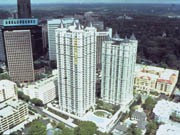Phase-Two of Atlanta Condo Sealed With Silicones

Designed with outstanding weather resistance as a top priority, sealing the Mayfair Renaissance Tower was a complex task. Despite excellent performance in the first tower, the architects wanted to be certain that each weather-sealing component demonstrated superior performance, and extensive testing was conducted at Construction Research Laboratories in Miami.
“The window and curtainwall systems were rigorously tested for water and air infiltration,” commented Matt Waddell of Hardin Construction, general contractor on the Phase-Two project. “The sealants, windows and other components were even subjected to simulations of a 120-mph, hurricane-force wind in a special chamber to confirm their weatherproofing performance.”
According to Jim Warbrouck at Curtainwall Design Consultants, exterior-wall consultant to the building owner, a preconstruction mockup was also used on-site to confirm structural and weatherproofing performance. “A test section was constructed, about 40 feet wide and approximately two stories high,” said Warbrouck. “The contractor built a section of the actual exterior as it was designed so it would be subjected to the same structural loading as the completed tower. Then we tested for air and water penetration to ensure that it would remain weather-tight. The silicone sealants demonstrated excellent adhesion and durability,” he added.
Flexibility Is Key
Expansion joints between EIFS panels at the Mayfair Renaissance were sealed with Dow Corning 790 silicone building sealant, an ultra-low-modulus, high-elongation material designed to deliver good adhesion to a wide range of substrates, including masonry, stone, wood, steel, aluminum and plastics. The material’s very low modulus was a key feature in the new design to avoid stressing the EIFS panels at the bond line. Its outstanding flexibility allows the sealant to absorb building movement, thermal expansion and other stresses.Dow Corning 790 building sealant is a one-part silicone formulation that cures to a durable, flexible, building-joint seal. With its strong adhesion and excellent recovery capability, the material delivers proven performance even in building joints that experience extreme movement. This high-movement capability also allows the repair of failed sealants, generally with no joint widening, saving time and labor costs.
For adhesion to metal window frames, Reynolds and his team specified Dow Corning 795 silicone building sealant, a high-performance structural glazing and weather-sealing formulation developed for use on glass, anodized and coated aluminum, steel and granite, as well as concrete, brick and a number of plastics. The newest Mayfair Renaissance tower has approximately 900 windows in its 296 residential units, along with nearly 600 sets of French doors for balcony access, all sealed with the same material that proved its capabilities in 315 units of the first phase.
Dow Corning 795 building sealant is a one-part, neutral-cure formulation for high-performance structural/non-structural glazing and weather-sealing applications. “The material flows easily in virtually any weather and cures rapidly at room temperature,” commented Mike Strickland of Metro Waterproofing. Durable and flexible enough to withstand up to ±50 percent movement in a properly designed joint, Dow Corning 795 sealant is virtually unaffected by UV exposure, rain, snow, ozone or extreme temperatures (-40 degrees F to 300 degrees F/-40 degrees C to 149 degrees C). Strickland estimated that his firm applied a total of 2,000 gallons of the two silicone sealants on the new tower.
A Weatherproofing Safeguard
In addition to the two silicone sealants, weatherproofing of the new tower included a secondary seal between the horizontal EIFS expansion joints. “The preformed design of the EIFS assembly includes an additional safeguard that incorporates Dow Corning 123 silicone seal,” explained building-exterior consultant Steve Gleason of Williamson and Associates. “The extruded seal acts as a gasket, so if water somehow were to migrate behind the primary seal, the preformed barrier of Dow Corning 123 would prevent it from traveling from floor to floor,” he said.Dow Corning 123 silicone seal is a preformed rubber extrusion used in a wide range of new construction and remedial applications as a joint seal for EIFS-to-EIFS applications and window-perimeter joints. The weatherproofing seal is also a fast, economical alternative to cutting out failed caulks and resealing joints where existing products have failed. Capable of withstanding significant joint movement, the extremely low-modulus elastomer can handle specified live loads, wind sway and seismic movements.
According to the architects, other critical elements to the sealant specification process were supplier-related. “We needed materials with proven performance, but we also wanted a single-point supplier who could handle all the weatherproofing needs, not multiple vendors providing a variety of different products,” said Specifications Writer Nancy Monroe from Smallwood, Reynolds. “In addition, the project required that both sealants be supplied in custom colors to precisely match the color scheme of the two buildings. We were able to meet all of these objectives with the Dow Corning materials, and the company provided excellent local support throughout the construction process,” she added.
For more information:
Fore more information on Dow Corning silicone building sealants, contact Dow Corning Corp., PO Box 0994, Midland, MI 48686-0994; phone 989-496-6000; fax 989-496-8026; or visit http://www.dowcorning.com/constructionLooking for a reprint of this article?
From high-res PDFs to custom plaques, order your copy today!



